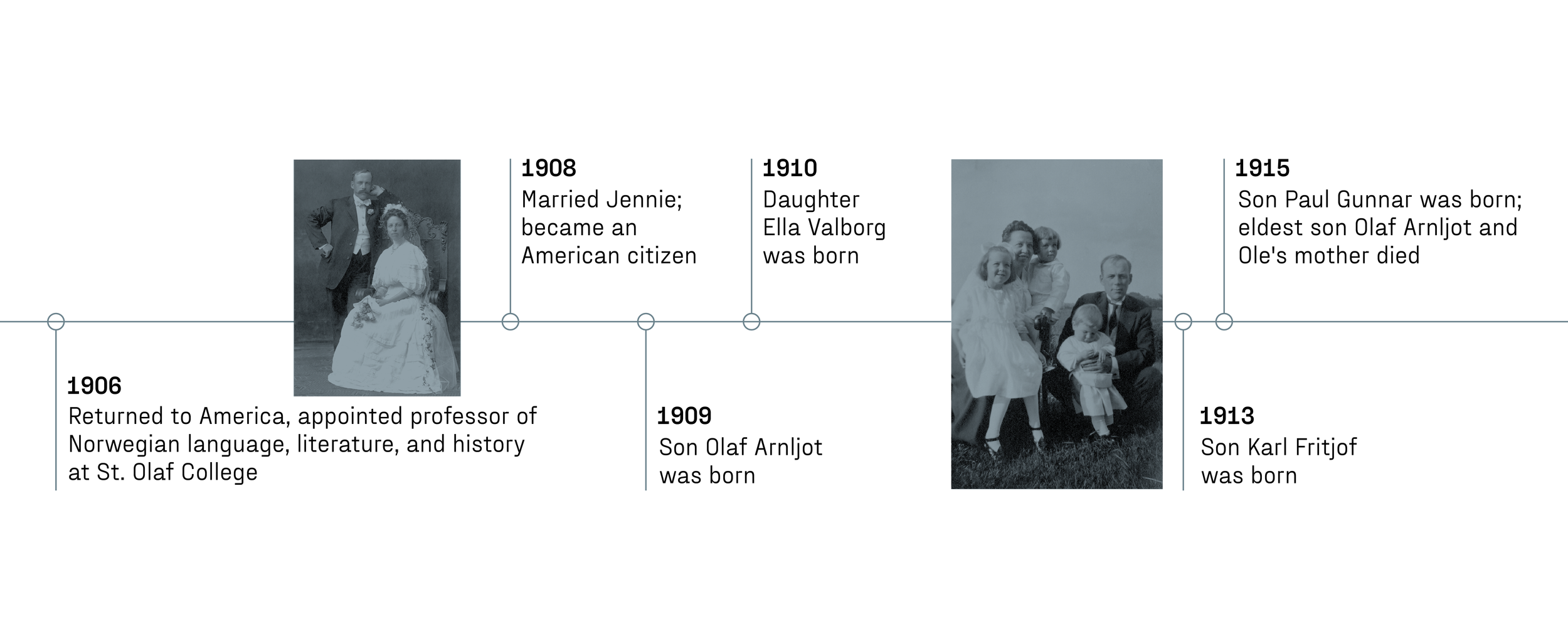Biography
Growing up on Dønna
Several of his siblings succumbed to tuberculosis at a young age, and Ole Edvart himself was frail during his childhood. The family's living conditions were often hand-to-mouth, with herring and potatoes as their staple diet during the late winter months.
Both his father and mother kept abreast of societal developments and were described as richly gifted. At home, they had a well-used Bible and subscribed to two Oslo-based newspapers, including Morgenposten, which was uncommon at the time. They studied each newspaper thoroughly and read aloud on dark autumn evenings. Schooling took place in Snekkevik for nine weeks each year. In winter, the children stayed overnight at school, while in spring and autumn, they walked the ten-kilometer journey home.
Ole Edvart Pedersen was born in Rølvåg on April 22, 1876, in a small sod-roofed cottage on a windswept headland facing the sea.
He was the third child in what would become a family of eight siblings.
The house at Dønna
Snekkevik school
Photos: Norwegian-American Historical Association.Ole Edvart became a ship’s cabin boy in Lofoten by the age of 14 and, growing to be an outstanding seaman and fisherman for his age. After the great storm on the Vestfjord on January 25, 1893, where he narrowly escaped, he decided to pursue education rather than become a fisherman, despite being offered his own boat. It was a difficult decision, and the skipper remarked, "You are a great fool." Ole Edvart continued to fish as a hobby throughout his life.
The Great Leap
Ole Edvart emigrated to America, driven by a strong desire to further his education and a dream of becoming a writer. The young man wrote to his uncle in America for help with a ticket shortly after the incident on the Lofoten Sea in 1893. The reply was delayed, but on August 6, 1896, Ole Edvart departed from Kristiania on the steamship D/S Norge, thanks to his uncle's assistance. Leaving home, and especially leaving his mother, burdended him greatly. Ole Edvart arrived in New York and continued his journey by train, taking three days, with only a few slices of bread to sustain him. By the time he reached Elk Point in South Dakota, he was nearly starving. A helpful Swede pointed him in the right direction and treated him to a sandwich and half a bottle of cold coffee.
In the early years, Ole Edvart worked on various farms around South Dakota, saving money for his education.
Jennie
Ole
Photos: Norwegian-American Historical Association.Ole as a student at
Augustana Academy
In the autumn of 1898, he enrolled as a student at Augustana Academy, a preparatory school for college-bound immigrant youth. Unable to forgo his income from farming, he started several months after the school term began. Despite having only 16 months of primary schooling, he quickly caught up with his peers.
Ole Edvart’s father believed that attending school was a waste of money, but Ole Edvart himself wrote, "it is the best thing I have ever done." He graduated with honors in the spring of 1901 and as such asked to deliver his classes commencement speech, where he highlighted three pillars of true education: the mother tongue, national characteristics, and inherited faith.
Having been offered a loan to study theology, Ole Edvart declined, as his primary interest lay in literature. In the autumn of 1901, he began his studies at St. Olaf College in Northfield, Minnesota, following the "classical" track, with a particular focus on Greek, as well as Latin, German, and French.
They lived in Northfield, Minnesota, for the rest of their lives.
During this time, he married Jennie, a second-generation immigrant. Jenny and Ole Edvart had four children together, two of whom died young.
D/S Norge





From Rejection to Success
Photos: Norwegian-American Historical Association.St. Olaf College offered Ole Edvart Rølvaag a loan for a year’s study of Norwegian language and literature in Kristiania, on the condition that he would subsequently return to the college as a Norwegian teacher. The dream of becoming a writer accompanied him to Kristiania, and he approached Aschehoug Publishing with the manuscript for the novel "Nils og Astri."
The book was rejected and never published. Nevertheless, he continued to write and authored several books published in association with the Norwegian-American church community.
Ole Edvart’s published his first two books under the pseudonym Paal Mørck, avoiding publishing under his own name until 1920. He also published several books during his teaching career, including co-editing the three volume "Norsk læsebok" (1919–25).
Rølvaag's main work, considered the pinnacle of Norwegian immigrant literature, consists of the four books:
- «I de dage» (1924)
- «Riket grundlægges» (1925)
- «Peder Seier» (1928)
- «Den signede dag» (1931)
Ole Edvart was in contact with many of the leading authors and intellectuals of his time, such as C.J. Hambro, Johan Bojer, Johan Falkberget, and Regine Normann. He actively participated in cultural debates and was particularly concerned with immigration and integration.
His cultural perspective was rooted in the belief that immigrants could better navigate the cultural melting pot of America by preserving their own language and cultural heritage. He was especially focused on mother tongue education and conducted lecture tours on the conditions for immigrants.
In 1930, he was nominated for the Nobel Prize in Literature for the series of books about Peder Seier.
The Journey













